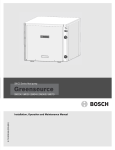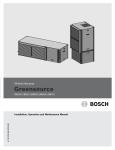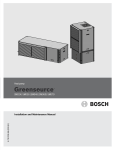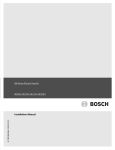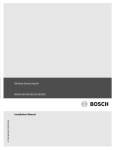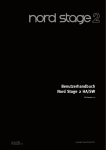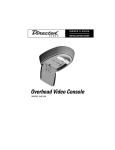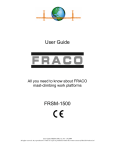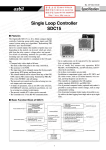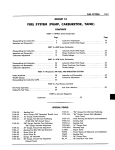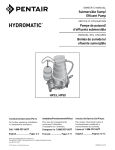Download Bosch SM024 Specifications
Transcript
SM AH Series Heat pump SM024 | SM036 | SM048 | SMO60 | SM070 873392084 (2013/11) Installation, Operation and Maintenance Manual 2| SM AH Series Heat Pump CONTENTS SYSTEM CHECKOUT.........................................................13 AH MODEL NOMENCLATURE .............................................. 3 KEY TO SYMBOLS .............................................................. 3 SAFETY WARNINGS ........................................................... 3 INITIAL INSPECTION .......................................................... 4 SM AH STANDARD PACKAGES ........................................... 4 GENERAL DESCRIPTION .................................................... 4 MOVING AND STORAGE ..................................................... 4 SAFETY CONSIDERATIONS................................................. 4 Location............................................................................ 4 Air Handler ................................................................. 4 Condensing Section ..................................................... 5 UNIT START-UP................................................................13 INITIAL START-UP ............................................................14 MAINTENANCE ................................................................14 OPERATING PRESSURES & TEMPERATURES......................15 UNIT CHECKOUT SHEET ...................................................20 TROUBLESHOOTING ........................................................21 WIRING DIAGRAMS..........................................................23 DIMENSIONAL DRAWINGS ...............................................25 NOTES.............................................................................27 Installation........................................................................ 5 Condensing Section ..................................................... 5 Mounting Vertical Air Handler Units ................................ 5 Mounting Horizontal Air Handler Units............................. 6 CONDENSATE DRAIN ......................................................... 6 DUCT SYSTEM................................................................... 7 ELECTRICAL ..................................................................... 7 Electric Heater Package Option...................................... 7 Low Voltage Control Wiring ........................................... 8 Electronic Thermostat Installation .................................. 9 ECM Interface Board .................................................. 10 Thermostat Connections............................................. 10 SEQUENCE OF OPERATION .............................................. 11 Cooling Mode ............................................................ 11 Heating Mode............................................................ 11 REFRIGERANT LINES ....................................................... 11 Linear vs Equivalent Line Length .................................. 12 Connecting Refrigerant Lines....................................... 12 CHARGING THE SYSTEM .................................................. 13 Figure 1: CS/AH Pairings UNIT MODEL Unit 1 SM024-1CSC SM024-1AVX SM036-1CSC SM036-1AVX SM048-1CSC SM048-1AVX SM060-1CSC SM060-1AVX SM070-1CSC SM070-1AVX Paired Air Handler Unit 3 Unit 4 DX025-1VTX DX025-1CCX DX035-1VTX DX035-1CCX DX049-1VTX DX049-1CCX DX061-1VTX DX061-1CCX DX071-1VTX DX071-1CCX Unit 2 SM024-1AHX SM036-1AHX SM048-1AHX SM060-1AHX SM070-1AHX Unit 5 DX025-1UCX DX035-1UCX DX049-1UCX DX061-1UCX DX071-1UCX Unit 6 DX035-1VTX DX049-1VTX DX071-1VTX LEGEND: AVX BOSCH box style Vertical Air Handler AHX BOSCH box style Horizontal Air Handler CCX Cased coil UCX Uncased coil VTX Motex unitary style air handler 873392084 (2013/11) Subject to change without prior notice SM AH Series Heat Pump SM AH Series Heat AH Model Nomenclature | 3 AH MODEL NOMENCLATURE SM 024 - 1 AV X - X L T A FAN MOTOR OPTIONS SERIES SM A - Constant Airflow ECM SIZE DISCHARGE AIR CONFIGURATION 024 036 048 060 070 T - Top (AV only) S - Straight (AH only) E - End (AH only) RETURN AIR CONFIGURATION L - Left R - Right X - None VOLTAGE DESIGNATIONS 1 - 208/1/60 & 230/1/60 CABINET CONFIGURATION Not Used for Air Handlers AH - Air Handler Horizontal AV - Air Handler Vertical Revision Level A Figure # 2 KEY TO SYMBOLS Warnings Warnings in this document are identified by a warning triangle printed against a grey background. Keywords at the start of the warning indicate the type and seriousness of the ensuing risk if measures to prevent the risk are not taken. The following keywords are defined and can be used in this document: • NOTE indicates a situation that could result in damage to property or equipment. • CAUTION indicates a situation that could result in minor to medium injury. • WARNING indicates a situation that could result in sever injury or death. • DANGER indicates a situation that will result in severe injury or death. SAFETY WARNINGS Installation and servicing of this equipment can be hazardous due to system pressure and electrical components. Only trained and qualified personnel should install, repair, or service the equipment. Before performing service or maintenance operations on the system, turn off main power to the unit. Electrical shock could cause personal injury or death. When working on equipment, always observe precautions described in the literature, tags, and labels attached to the unit. Follow all safety codes. Wear safety glasses and work gloves. Use a quenching cloth for brazing, and place a fire extinguisher close to the work area. Important Information This symbol indicates important information where there is no risk to property or people. Revised 11-13 All refrigerant discharged from this unit must be recovered WITHOUT EXCEPTION. Technicians must follow industry accepted guidelines and all local, state, and federal statutes for the recovery and disposal of refrigerants. If a compressor is removed from this unit, refrigerant circuit oil will remain in the compressor. To avoid leakage of compressor oil, refrigerant lines of the compressor must be sealed after it is removed. 873392084 (2013/11) 4 | INITIAL INSPECTION SM AH Series Heat Pump To avoid equipment damage, DO NOT use these units as a source of heating or cooling during the construction process. Doing so may affect the unit’s warranty. The mechanical components and filters will quickly become clogged with construction dirt and debris, which may cause system damage. INITIAL INSPECTION Be certain to inspect all cartons or crates on each unit as received at the job site before signing the freight bill. Verify that all items have been received and that there are no visible damages; note any shortages or damages on all copies of the freight bill. In the event of damage or shortage, remember that the purchaser is responsible for filing the necessary claims with the carrier. Concealed damages not discovered until after removing the units from the packaging must be reported to the carrier within 24 hours of receipt. SM AH STANDARD PACKAGE S MOVING AND STORAGE If the equipment is not needed for immediate installation upon its arrival at the job site, it should be left in its shipping carton and stored in a clean, dry area. Units must only be stored or moved in the normal upright position as indicated by the “UP” arrows on each carton at all times. If unit stacking is required, stack units as follows: Vertical units no more than two high. Horizontal units no more than three high. SAFETY CONSIDERATIONS Installation and servicing of this equipment can be hazardous due to system pressure and electrical components. Only trained and qualified personnel should install, repair, or service the equipment. Untrained personnel can perform basic functions of maintenance such as cleaning coils and replacing filters. When working on equipment, always observe precautions described in the literature, tags, and labels attached to the unit. Follow all safety codes. Wear safety glasses and work gloves. Use a quenching cloth for brazing, and place a fire extinguisher close to the work area. The air handler blower should only be operated when a duct is installed and secured to heat pump duct collar in order to avoid possible injury. 1 LOCATION 2 To maximize system performance, efficiency and reliability, and to minimize installation costs, it is always best to keep the refrigerant lines as short as possible. Every effort should be made to locate the air handler and the condensing section as close as possible to each other. Air Handler [1] SM Series Water-to-Air Heat Pump: Air Handler [2] Installation and Operation Manual GENERAL DESCRIPTION These Split System Heat Pumps provide the best combination of performance and efficiency available. Safety devices are built into each unit to provide the maximum system protection possible when properly installed and maintained. The SM Split Water-to-Air Heat Pumps are Underwriters Laboratories (UL) and (cUL) listed for safety. All SM Water-to-Air Heat Pumps conform to UL1995 standard and are certified to CAN/CSA C22.1 No 236 by Intertek-ETL 873392084 (2013/11) Locate the air handler unit in an indoor area that allows easy removal of the filter and access panels, and has enough room for service personnel to perform maintenance or repair. Provide sufficient room to make electrical and duct connections. If the unit is located in a confined space such as a closet, provisions must be made for return air to freely enter the space. On horizontal units, allow adequate room below the unit for a condensate drain trap. The air handler units are not approved for outdoor installation; therefore, they must be installed inside the structure being conditioned. Do not locate in areas that are subject to freezing. Subject to change without prior notice SM AH Series Heat Pump SM AH Series Heat Installation | 5 Condensing Section Locate the condensing section in an area that provides sufficient room to make water and electrical connections, and allows easy removal of the access panels, for service personnel to perform maintenance or repair. Consult the condensing section of this manual for more information, or your CS factory’s tech support. If the condensing section is installed in a location where ambient temperatures can fall below freezing, some form of freeze protection should be employed such as anti-freeze. Where the use of anti-freeze is not possible for example in a ground water application the fluid circulating pump should operate continuously to prevent possible condenser freeze-up and to optimize overall system performance. Consult the factory in these instances for guidance. Water freezes at 32°F. Frozen water coils are not covered under the limited product warranty. It is the installer’s responsibility to insure that the condensing section is installed in a location or has the proper controls to prevent rupturing the water coil due to freezing conditions. AH CS Figure # 3 INSTALLATION Remove all shipping blocks under blower housing. Do not remove the protective caps or plugs from the service valves until the refrigerant lines are run and ready for final connection. Mounting Vertical Air Handler Units Vertical units should be mounted level on a vibration absorbing pad slightly larger than the base to minimize vibration transmission to the building structure. (See Figure #4) The installer should comply with all local codes and regulations which govern the installation of this type of equipment. Local codes and regulations take precedent over any recommendations contained in these instructions. In lieu of local codes, the equipment should be installed in accordance with the recommendations made by the National electric code, and in accordance with the recommendations made by the National Board of Fire Underwriters. All local seismic codes for seismic restraint of equipment, piping, and duct work shall be strictly adhered to. Condensing Section Vibration Pad Full Size Figure # 4 Locate the condensing section in an area that provides sufficient space to make water and electrical connections, allowing easy removal of the access panels. A 36" clearance in front of the unit is recommended. This will ensure proper work space for service personnel to perform maintenance or repair. Revised 11-13 873392084 (2013/11) 6 | CONDENSATE DRAIN SM AH Series Heat Pump Mounting Horizontal Air Handler Units While horizontal units may be installed on any level surface strong enough to hold their weight, they are typically suspended above a ceiling by threaded rods. The rods are usually attached to the unit corners by hanger bracket kit. (See Figure #5). The rods must be securely anchored to the ceiling. Refer to the hanging bracket assembly and installation instructions for details. All units require four mounting brackets at the corners. Horizontal units installed above the ceiling must conform to all local codes. An auxiliary drain pan if required by code, should be at least four inches larger than the bottom of the heat pump. Plumbing connected to the heat pump must not come in direct contact with joists, trusses, walls, etc. CONDENSATE DRAIN If equipped with float style condensate overflow switch, final adjustment must be made in the field. Make sure that the unused drain pan opening is plugged prior to operating the air handler. The air handler should be pitched approximately 1/ 4" towards the drain in both directions, to facilitate condensate removal. A drain line must be connected to the air handler and pitched away from the unit a minimum of 1/8" per foot to allow the condensate to flow away from the unit. This connection must be in conformance with local plumbing codes. A trap must be installed in the condensate line to insure free condensate flow. (Units are not internally trapped). A vertical air vent is sometimes required to avoid air pockets. (See Figure #6). The length of the trap depends on the amount of positive or negative pressure on the drain pan. A second trap must not be included. Figure # 5 Some applications require an attic floor installation of the horizontal air handler unit. In this case the unit should be set in a full size secondary drain pan on top of a vibration absorbing mesh. The secondary drain pan prevents possible condensate overflow or water leakage damage to the ceiling. The secondary drain pan is usually placed on a plywood base isolated from the ceiling joists by additional layers of vibration absorbing mesh. In both cases, a 3/4" drain connected to this secondary pan should be run to an eave at a location that will be noticeable. If the unit is located in a crawl space, the bottom of the unit must be at least 4” above grade to prevent flooding of the electrical parts due to heavy rains. Figure # 6 The condensing unit should be pitched approximately 1/4" towards the drain in both directions, to facilitate condensate removal. (See Figure #6) Figure # 7 873392084 (2013/11) Subject to change without prior notice SM AH Series Heat Pump SM AH Series Heat DUCT SYSTEM A supply air outlet collar and return air duct flange are provided on all units to facilitate duct connections. Refer to the FHP individual data specification sheet for physical dimensions of the collar and flange. A flexible connector is recommended for supply and return air duct connections on metal duct systems. All metal ducting should be insulated with a minimum of one inch duct insulation to avoid heat loss or gain and prevent condensate forming during the cooling operation. Application of the unit to uninsulated duct work is not recommended as the unit’s performance will be adversely affected. Do not connect discharge ducts directly to the blower outlet. The factory provided air filter must be removed when using a filter back return air grill. The factory filter should be left in place on a free return system. If the unit will be installed in a new installation which includes new duct work, the installation should be designed using current ASHRAE procedures for duct sizing. If the unit is to be connected to existing ductwork, a check should be made to assure that the duct system has the capacity to handle the air required for the unit application. If the duct system is too small, larger ductwork should be installed. Check for existing leaks and repair as necessary to ensure an air tight seal within the duct. The duct system and all diffusers should be sized to handle the designed air flow quietly. To maximize sound attenuation of the unit blower, the supply and return air plenums should be insulated. There should be no direct straight air path thru the return air grille into the heat pump. The return air inlet to the heat pump must have at least one 90 degree turn away from the space return air grille. If air noise or excessive air flow are a problem, the blower speed can be changed to a lower speed to reduce air flow. (Refer to ECM motor interface board section in this manual and Figure #8) Revised 11-13 DUCT SYSTEM | 7 ELECTRICAL Always disconnect power to the unit before servicing to prevent injury or death due to electrical shock or contact with moving parts. All field wiring must comply with local and national fire, safety and electrical codes. Power to the unit must be within the operating voltage range indicated on the unit’s nameplate. Operating the unit with improper line voltage or with excessive phase imbalance is hazardous to the unit and constitutes abuse and is not covered under warranty. Properly sized fuses or HACR circuit breakers must be installed for branch circuit protection. See equipment rating plates for maximum size. Both the air handler and condensing units are provided with a concentric knock-out in the front right corner post for attaching common trade sizes of conduit. Route power supply wiring through this opening. Flexible wiring and conduit should be used to isolate vibration and noise from the building structure. Be certain to connect the ground lead to the ground lug in each of the control boxes. Connect the power leads as indicated on the unit wiring diagrams. Electric Heater Package Option Factory installed internal electric heater packages are available for all units. Two circuit breakers are required when heater packages are utilized. The circuit breakers for the heater package provide power for the heater elements, the blower motor and the control circuit for the unit. The circuit breaker for the unit provides power for the compressor. This allows the electric heaters to continue to operate along with the blower motor in the case of unit compressor and/or compressor power supply failure. See HP Series Heater Kit Instructions for field installation. Each SM Series model has a number of heater sizes available. Refer to Figure #7 for heater package compatibility with specific SM Series units, models nomenclature and electrical data. 873392084 (2013/11) 8 | Electrical SM AH Series Heat Pump Low Voltage Control Wiring The SM series units incorporate the ECM variable speed fan motor and control interface board. The thermostat should be connected to the air handlers and then from the air handler to the condensing section. The low voltage power supply is located in the air handler. In this application utilize a 9 conductor cable from the thermostat to the air handler and 7 conductor cable from the air handler to the condensing section. Each model has a number of heater sizes available. Refer to Figure #7 for heater package compatibility with specific units, model nomenclature and electrical data Figure 8: Motor Profile Air Flow Table CFM - Two Stage Units Model Fan Only Y1 COOL/ Y2 COOL/ HEAT HEAT AUX HEAT EMERG HEAT PLUS ADJ MINUS ADJ TAP COOL/ HEAT/DELAY SM024 450 500 800 800 800 900 700 A SM036 700 1050 1225 1225 1225 1400 1050 A SM048 900 925 1500 1500 1500 1700 1275 B SM060 1200 1500 2000 2000 2000 2300 1700 A SM070 1600 1600 2200 2200 2200 2300 1900 A Figure 9: Heater Package Compatibility Model Heater Model KW Heater Amps 208V 240V Circuit MCA Max. Fuse 208V 240V 208V 240V AWG Min. SM024 thru 070 HP050-1XS 4.8 17.3 20.0 L1/L2 27.1 30.4 30 30 8 SM024 thru 070 HP100-1XS 9.6 34.7 40.0 L1/L2 48.8 55.4 50 60 6 SM036 thru 070 HP100-1XM 9.6 34.7 40.0 L1/L2 49.5 56.3 50 60 6 HP150-1XM 14.4 52.0 60.0 SINGLE 71.2 81.3 80 90 4 HP150-1XM 14.4 34.7 40.0 L1/L2 49.5 56.3 60 60 6 17.3 20.0 L3/L4 21.7 25.0 25 25 10 SM048 thru 070 SM048 thru 070 HP200-1XM 19.2 69.3 80.0 SINGLE 92.9 106.3 100 110 2 HP200-1XM 19.2 34.7 40.0 L1/L2 49.5 56.3 50 60 6 34.7 40.0 L3/L4 43.4 50.0 45 50 6 All heaters rated single phase 60 Hz, and include unit fan load. All fuses type “D” time delay or HACR type breaker or HRC FORM 1. Wire size based on 60 deg. C copper conductors. 873392084 (2013/11) Subject to change without prior notice SM AH Series Heat Pump SM AH Series Heat Electrical | 9 Units supplied with internal electric heat require two (2) separate power supplies: one for the unit compressor and one for the electric heater elements, blower motor and control circuit. Refer to Figure #7 for wiring instructions, minimum circuit ampacities and maximum fuse/ breaker sizing. Electronic Thermostat Installation Position the thermostat subbase against the wall so that it is level and the thermostat wires protrude through the middle of the subbase. Mark the position of the subbase mounting holes and drill holes with a 3/16-inch bit. Install supplied anchors and secure base to the wall. Thermostat wire must be 8-conductor, 18-AWG wire. Strip the wires back 1/4-inch (longer strip lengths may cause shorts) and insert the thermostat wires into the connector as shown. Tighten the screws to ensure secure connections. The thermostat has the same type connectors, requiring the same wiring. See instructions in the thermostat for detailed installation and operation information. When using a 2-cool, 3-heat thermostat both the W1 & W2 on the Heat Pump and W2 & EM on the thermostat must be connected together via a jumper. (See Figure#10) PACKAGED HEAT PUMP THERMOSTAT R R G Y1 Y1 Y2 Y2 C G O C B O W1 B W2 E W2 Figure # 10 Revised 11-13 Packaged heat pumps are equipped with detachable Thermostat connectors. These connectors are located in different locations based on the blower motor that is installed in the unit. For the EON motor, the three detachable thermostat connectors are located on the ECM Interface board. See Wiring Harness Drawing on Pg#54. Harness wiring can be loose, based on the options installed for the unit. See the Wiring Harness Drawing notes for further details. Connection point logic is as follows: Figure 11: Low Voltage Connection Points Function To From To Air From Air Condensing Thermostat Handler Handler Section 24 HVAC Common C C C C 24 VAC Hot R R R R Fan Operation G G Reversing Valve (3) O O O O 1st Stage Compressor Operation Y1 Y1 Y1 Y1 2nd Stage Compressor Operation Y2 Y2 Y2 Y2 CS CS Condensate Sensor (1) Alarm Output (From UPM) (2) L Splice Auxilliary Electric Heat (4) W/W1/W2 W1 Emergency Heat (4) E EM/W2 ALR 873392084 (2013/11) 10 | Electrical 1. 2. 3. 4. SM AH Series Heat Pump For the condensate overflow sensor, connect ‘CS’ at the condensing section to ‘CS’ at the air handler. Be sure to ground power supply. If service LED is utilized connect ‘ALR’ terminal on the UPM board to ‘L’ on the thermostat sub base. The wiring may be spliced in the air handling unit. The ALR output is always dry contact between the OUT and COM Terminals. See Thermostat connections section of this manual for additional information. ‘O’ – reversing valve is energized in the cooling mode. Fail safe is to heating. Utilized when electric strip heater package present. If the unit is being connected to a thermostat with a malfunction light, this connection is made at the unit alarm output. If the thermostat is provided with a malfunction light powered off of the common (C) side of the transformer, a jumper between “R” and “COM” terminal of “ALR” contacts must be made. ECM Interface Board If the thermostat is provided with a malfunction light powered off of the hot (R) side of the transformer, then the thermostat malfunction light connection should be connected directly to the (ALR) contact on the unit’s UPM board. To the left of the thermostat connection block are a row of 2 red and 4 green LED’s. These LED’s indicate the operating status of the unit. They are labeled as follows: Figure # 12 THERMOSTAT CONNECTIONS Thermostat wiring is connected to the 10 pin screw type terminal block on the lower center portion of the ECM Interface Board. In addition to providing a connecting point for thermostat wiring, the interface board also translates thermostat inputs into control commands for the variable speed programmable ECM DC fan motor and displays an LED indication of operating status. The thermostat connections and their functions are as follows: Y2 Second Stage Compressor Operation Y1 First Stage Compressor Operation G Fan O Reversing Valve (energized in cooling) W1 Auxiliary Electric Heat (runs in conjunction with compressor) EM/W2 Emergency Heat (electric heat only) NC Transformer 24 VAC Common (extra connection) C1 Transformer 24 VAC Common (primary connection) R Transformer 24 VAC Hot HUM Dehumidification Mode 873392084 (2013/11) EM RED Emergency Heat On W1 RED Auxiliary Heat On O GREEN Reversing Valve Energized, unit is in cooling mode Y2 GREEN Second Stage Compressor On Y1 GREEN First Stage Compressor On G GREEN Fan On Just above the connector block is a single red LED labeled CFM that will blink intermittently when the unit is running and may flicker when the unit is off. This LED indicates the air delivery of the blower at any given time. Each blink of the LED represent 100 CFM of air delivery so if the LED blinks 12 times, pauses, blinks 12 times, etc. the blower is delivering 1200 CFM. Refer to Figure #10 for factory programmed air delivery settings for the SM Series. Subject to change without prior notice SM AH Series Heat Pump SM AH Series Heat Just above and to the right of the thermostat connection block are four sets of jumper pins labeled ADJ, DELAY, HEAT and COOL. The ADJ set of pins are labeled NORM, (+), (-) and TEST. AP units will all be set on the NORM position from the factory, however, airflow can be increased (+) or decreased (-) by 15% from the pre-programmed setting by relocating the jumper in this section. The TEST position is used to verify proper motor operation. If a motor problem is suspected, move the ADJ jumper to the TEST position and energize G on the thermostat connection block. If the motor ramps up to 100% power, then the motor itself is functioning normally. Always remember to replace the jumper to NORM, (+) or (-) after testing and reset the unit thermostat to restore normal operation. Do not set the ADJ jumper to the (-) setting when electric heaters are installed. Doing so may cause the heaters to cycle on their thermal overload switches, potentially shortening the life of the switches. The other three sets of jumper pins are used to select the proper program in the ECM motor for the unit. Refer to Figure #7 for the proper jumper placement. To the left of the red and green status LED’s is a row of 1/4” male quick connects. These are used to pass thermostat inputs on to the rest of the control circuit. Remember to always turn off unit power at the circuit breaker before attaching or disconnecting any wiring from these connections to avoid accidental short circuits that can damage unit control components. SEQUENCE OF OPERATION Cooling Mode See Typical Wiring Diagram at the end of the manual. Energizing the “O” terminal energizes the unit reversing valve in the cooling mode. The fan motor starts when the “G” terminal is energized. When the thermostat calls for cooling (Y), the loop pump or solenoid valve if present is energized and compressor will start. Once the thermostat is satisfied, the compressor shuts down accordingly and the fan ramps down to either fan only mode or off over a span of 30 seconds (ECM Motors). Note that a fault condition initiating a lockout will de-energize the compressor. Revised 11-13 Sequence of operation | 11 Heating Mode Heating operates in the same manner as cooling, but with the reversing valve de-energized. The compressor will run until the desired setpoint temperature on the thermostat is achieved. Once the thermostat is satisfied, the compressor shuts down and the fan ramps down in either fan only mode or turns off over a span of 30 seconds. Auxiliary electric heating coils are not available on the EP product line. REFRIGERANT LINES The installation of the copper refrigerant tubing must be done with care to obtain reliable, troublefree operation. This installation should only be performed by qualified refrigeration service and installation personnel. Refrigerant lines generally can and should be routed and supported so as to prevent the transmission of vibrations into the building structure. Experience and good design practice dictate 75 feet as the maximum practical length for interconnecting refrigerant lines in split system heat pumps without special considerations. Beyond 75 feet, system losses become substantial and the total refrigerant charge required can compromise the reliability and design life of the equipment. Refrigerant lines should be sized in accordance with Figure #13 in the following instructions. Copper tubing should be clean and free of moisture and dirt or debris. The suction and liquid lines MUST be insulated with at least 3/8” wall, closed-cell foam rubber insulation or the equivalent. Some points to consider are: • Pressure drop (friction losses) in refrigerant suction lines reduces system capacity and increases power consumption by as much as 2% or more, depending on the line length, number of bends, etc. Pressure drop in liquid lines affects system performance to a lesser degree, provided that a solid column of liquid (no flash gas) is being delivered to the refrigerant metering device, and that the liquid pressure at the refrigerant metering device is sufficient to produce the required refrigerant flow. 873392084 (2013/11) 12 | Refrigerant Lines • • • SM AH Series Heat Pump Oil is continually being circulated with the refrigerant so, oil return to the compressor is always a consideration in line sizing. Suction lines on split system heat pumps are also hot gas lines in the heating mode, but are treated as suction lines for sizing purposes. If the recommended suction lines sizes are used, there should be no problem with oil return. Vertical lines should be kept to a minimum. Vertical liquid lines will have a vertical liquid lift in either heating or cooling, and the weight of the liquid head is added to the friction loss to arrive at the total line pressure drop. Wherever possible, the air handler should be installed at a higher elevation than the condensing section to aid with oil return to the compressor. Linear vs Equivalent Line Length Linear Line Length - is the actual measured length of the line including bends. This issued to calculate the additional refrigerant charge thatm ust be added to the system. (See Figure #15 and examples) Equivalent Line Length - is the combination of the actual length of all the straight runs and the equivalent length of all bends valves and fittings in a particular line. The equivalent length of a bend, valve or fitting is equal to the length of a straight tube of the same diameter having the same pressure drop as the particular valve or fitting. The ASHRAE Fundamentals Handbook provides tables for determining the equivalent length of various bends, valves and fittings. Liquid and suction line sizes as shown in Figure #14 are based on Equivalent Line Length. • • • Connect and braze lines to service valves on the condensing section. WARNING: Always wrap the body of the service valve with a wet towel or apply some other form of heatsink prior to brazing and direct flame away from the valve body. Failure to do so will result in damage to the valve. Valve bpdy temperature must remain below 250°F to protect the internal rubber “O” rings and seals. Figure 13: Valve Sizing Chart Line Type Valve Conn. Size Allen Wrench size SM024/036 Suction 3/4 5/16 SM048/060/070 Suction 7/8 5/16 Liquid 3/8 3/16 Unit Size All Valves Valve top Schraeder Port Figure # 14 Connecting Refrigerant Lines • • Use only ACR grade copper tubing and keep ends sealed until joints are made. For best performance, select routing of refrigerant lines for minimum distance and fewest number of bends. Size lines in accordance with Figure #15. Cut crimped ends off the air handler suction and liquid lines. Connect and braze lines to the air handler. Pressurize the refrigerant line set and air handler to 150lbs with dry nitrogen through the Schraeder ports provided on the self service valves. Check line set and unit connections for leaks. Once system integrity is verified, evacuate line set and air handler with a good vacuum pump to 500 microns and hold for half hour. Pump down must never be used with heat pumps. The air handler is factory supplied with a holding charge of dry nitrogen. 873392084 (2013/11) Subject to change without prior notice SM AH Series Heat Pump SM AH Series Heat Charging the system | 13 CHARGING THE SYSTEM • Do not overcharge the system. Charge all systems by weight as determined from Figure #15 and the supplied factory charge. Remember the condensing unit is factory charged with sufficient refrigerant to support the air handler, condensing section and 25 feet of liquid line. If the lines are less orm ore than 25 feet, then a charge adjustment must be calculated. Refer to examples #1 and #2 in Figure #15.. DANGER: High pressure refrigerant gas and liquid is present in the unit. Liquid refrigerant can cause severe burns to exposed skin areas. Wear safety glasses to protect the eyese. Liquid refrigerant in contact with the eyes could cause loss of sight. If the calculated Equivalent Line Length falls between the lengths shown on Table 3, use tubing sized for the next longer length. Maximum Linear (actual) liquid line length without a suction line accumulator is 60 feet. Liquid line length in excess of 100 feet is not recommended either with or without a suction line accumulator. A liquid line drier-filter is required, it must be of the bidirectional type only and approved for the refrigerant type utilized. Suction line size must be one of those given in Figure #15. Horizontal suction line runs should be pitched slightly toward the compressor to provide free drainage and aid oil return. Do not exceed the largest diameter given in the tables on horizontal runs. When brazing always bleed dry nitrogen through refrigerant tubing to displace air and prevent oxidation. Air handler is pre-charged in the factory with nitrogen gas. Cut air handler piping with care. • • • • Open both service valves in the condensing section by turning the valve stops located at the top of each valve counter-clockwise with an Allen wrench. Make sure that both valves are fully open. THINGS TO REMEMBER: • Do not oversize liquid lines unless absolutely unavoidable. If oversized lines must be used, a suction line accumulator may be required and the addition of a crankcase heater may be necessary. Consult the Factory for recommendation. • • DANGER: Always check refrigerant type on the unit data plate before servicing. Do not use R-22 manifold gauges on R-410A units. Doing so could result in severe injury. Figure 15: Refrigerant Charge, Line Sizing and Capacity Multiplier Chart SYSTEM MODEL Factory R410A Charge (Oz)* Refrigerant Line O.D. Size (Based on Equivalent Line Length) 25 FT. 35 FT. 45 FT. 50 FT. Suct. Line Riser Max. 75 FT LIQ. SUC. LIQ. SUC. LIQ. SUC. LIQ. SUC. LIQ. SUC. SM024 80 3/8 3/4 3/8 3/4 3/8 3/4 3/8 3/4 3/8 7/8 3/4 SM036 86 3/8 3/4 3/8 3/4 3/8 3/4 3/8 7/8 3/8 7/8 3/4 SM048 88 3/8 7/8 3/8 7/8 3/8 7/8 3/8 7/8 3/8 7/8 7/8 SM060 115 3/8 1-1/8 3/8 1-1/8 3/8 1-1/8 3/8 1-1/8 3/8 1-1/8 7/8 SM070 127 3/8 1-1/8 3/8 1-1/8 3/8 1-1/8 3/8 1-1/8 3/8 1-1/8 7/8 CAPACITY MULTIPLIER 1.00 .995 Example 1: Model SM036 with 45ft of equivalent length of 3/8” O.D Liquid Line. Total system charge= Factory charge + (45ft - 25 ft) x .60 oz/ft Total System Charge = 93 oz + (20ft x .60 oz/ft) = 105 oz. Additional 12 oz of R410A refrigerant required. Revised 11-13 0.990 0.990 0.980 Example 2: Model SM060 with 10ft of equivalent length of 3/8” O.D Liquid Line. Total system charge= Factory charge + (25ft 10ft) x .60 oz/ft Total System Charge = 150 oz + (15ft x .60 oz/ft) = 141 oz. Additional 12 oz of R410A refrigerant required. 873392084 (2013/11) 14 | SYSTEM CHECKOUT SM AH Series Heat Pump SYSTEM CHECKOUT INITIAL START-UP After completing the installation, and before energizing the unit, the following system checks should be made: • Verify that the supply voltage to the heat pump is in accordance with the nameplate ratings. • Make sure that all electrical connections are tight and secure. • Check the electrical fusing and wiring for the correct size. • Verify that the low voltage wiring between the thermostat and the unit is correct. • Verify that the water piping is complete and correct. • Check that the water flow is correct, and adjust if necessary. • Check the blower for free rotation, and that it is secured to the shaft. • Verify that vibration isolation has been provided. • Unit is serviceable. Be certain that all access panels are secured in place. 1. Make sure all valves in heat recovery water piping system are open. NEVER OPERATE HR PUMP DRY. 2. Turn on the heat pump. The HR pump should not run if the compressor is not running. 3. turn the HR switch to the “ON” position. The pump wil operate if entering water temperature to HR is below 120° F. 4. The temperature difference between the water entering and leaving the heat recovery should be 5° to 15° F. UNIT START-UP 1. Set the thermostat to the highest setting. 2. Set the thermostat system switch to "COOL", and the fan switch to the "AUTO" position. The reversing valve solenoid should energize. The compressor and fan should not run. 3. Reduce the thermostat setting approximately 5 degrees below the room temperature. 4. Verify the heat pump is operating in the cooling mode. 5. Turn the thermostat system switch to the "OFF" position. The unit should stop running and the reversing valve should deenergize. 6. Leave the unit off for approximately (5) minutes to allow for system equalization. 7. Turn the thermostat to the lowest setting.Set the thermostat switch to "HEAT". 8. Increase the thermostat setting approximately 5 degrees above the room temperature. 9. Verify the heat pump is operating in the heating mode. 10. Set the thermostat to maintain the desired space temperature. 11. Check for vibrations, leaks, etc... 873392084 (2013/11) MAINTENANCE 1. Filter changes or cleanings are required at regular intervals. The time period between filter changes will depend upon type of environment the equipment is used in. In a single family home, that is not under construction, changing or cleaning the filter every 60 days is sufficient. In other applications such as motels, where daily vacuuming produces a large amount of lint, filter changes may be need to be as frequent as biweekly. WARNING: Equipment should never be used during construction due to likelihood of wall board dust accumulation in the air coil of the equipment which permanently affects the performance and may shorten the life of the equipment. 2. An annual “checkup” is recommended by a licensed refrigeration mechanic. Recording the performance measurements of volts, amps, and water temperature differences (both heating and cooling) is recommended. This data should be compared to the information on the unit’s data plate and the data taken at the original startup of the equipment. 3. Lubrication of the blower motor is not required, however may be performed on some motors to extend motor life. Use SAE-20 nondetergent electric motor oil. 4. The condensate drain should be checked annually by cleaning and flushing to insure proper drainage. Subject to change without prior notice SM AH Series Heat Pump SM AH Series Heat | 15 5. Periodic lockouts almost always are caused by air or water flow problems. The lockout (shutdown) of the unit is a normal protective measure in the design of the equipment. If continual lockouts occur call a mechanic immediately and have them check for: water flow problems, water temperature problems, air flow problems or air temperature problems. Use of the pressure and temperature charts for the unit may be required to properly determine the cause. Revised 11-13 873392084 (2013/11) 16 | Operating Pressures & Temperatures SM AH Series Heat Pump OPERATING PRESSURES & TEMPERATURES Operating Temperatures and Pressures COOLING Model Entering Water Temp. F 30° 40° 50° SM024 Part Load 60° 70° 80° 90° 100° 30° 40° 50° SM024 Full Load 60° 70° 80° 90° 100° Wat er Flow Suction Pressure PSIG Discharge Pressure PSIG HEATING Water Temp Rise °F Air Temp Drop °F Suction Pressure PSIG Discharge Pressure PSIG Water Temp Drop Air Temp Rise °F 4 75-91 264-322 5-6 15-17 8 79-96 270-331 3-4 16-18 4 88-107 277-339 6-7 17-20 8 115-140 175-214 8-9 19-23 92-112 284-348 4-5 18-21 4 129-157 218-267 14-17 18-20 98-122 291-356 7-8 20-23 8 124-151 204-250 8-9 19-22 110-130 298-364 5-6 21-24 4 134-163 249-305 13-16 17-20 112-136 304-372 8-10 22-26 8 128-156 233-287 8-9 18-21 117-143 312-381 6-7 23-28 4 138-168 281-341 13-16 17-19 124-152 318-389 9-11 24-29 8 133-161 263-323 7-9 18-21 131-159 325-398 6-8 26-31 4 143-174 317-388 13-16 16-19 136-166 331-405 11-13 27-32 8 137-167 297-366 7-9 17-20 143-174 339-415 7-9 28-33 4 147-179 357-437 13-16 16-18 149-181 345-422 12-14 29-35 8 141-172 335-411 7-9 17-20 156-190 352-432 8-10 31-37 4 151-185 402-492 13-15 15-18 8 146-177 378-459 7-9 16-19 4 76-92 242-297 3-4 13-14 8 80-97 249-304 2-3 13-15 89-108 255-312 4-5 15-17 4 125-151 180-221 14-18 19-22 8 120-146 4 134-163 169-207 8-10 20-23 93-113 261-320 3-3 16-18 211-258 14-18 18-21 106-118 267-327 5-6 8 17-19 129-157 198-242 8-10 19-23 110-126 274-335 3-4 18-21 4 139-169 241-295 14-17 18-21 113-138 280-342 6-7 19-22 8 134-163 227-278 8-10 19-22 119-145 287-351 4-5 20-23 4 144-175 272-333 14-17 17-20 126-155 292-358 7-8 21-24 8 138-168 255-313 8-10 18-21 133-162 300-367 5-6 22-26 4 148-181 307-375 14-17 17-19 138-168 305-373 8-9 23-27 8 143-174 288-353 8-10 18-21 145-177 312-382 5-6 24-29 4 153-186 346-423 14-17 16-19 151-184 317-388 8-10 25-29 8 147-179 325-398 8-9 17-20 158-193 325-398 6-7 26-31 4 158-191 389-477 13-16 16-18 8 152-185 366-448 8-9 17-20 This chart shows approximate temperatures and pressures for a unit in good repair. The values shown are meant as a guide only and should not be used to estimate system charge. This chart assumes rated air flow and 80º d.b./67º w.b. entering air temperature in cooling, 70º d.b. entering air temperature in heating. Heating data at entering fluid temperatures below 50º assumes the use of antifreeze. As a result of continuing research and development, specifications are subject to change without notice. 873392084 (2013/11) Subject to change without prior notice SM AH Series Heat Pump SM AH Series Heat Operating Pressures & Temperatures | 17 Operating Temperatures and Pressures COOLING HEATING 4.5 30° 40° 50° SM036 Part Load 60° 70° 80° 90° 100° 9.0 40° 50° SM036 Full Load 60° 70° 80° 90° 100° 266-325 5-6 15-18 77-94 272-333 3-4 16-19 4.5 117-143 189-231 14-17 18-22 86-105 279-341 6-7 17-21 9.0 112-137 178-217 8-9 19-24 90-110 286-350 4-5 18-22 4.5 126-154 221-270 14-17 18-21 105-125 293-358 7-8 20-24 9.0 121-148 207-253 8-9 19-23 109-130 300-366 5-6 21-25 4.5 131-160 252-308 13-16 17-21 110-134 306-374 8-10 22-27 9.0 125-153 237-290 8-9 18-22 115-141 314-383 6-7 23-29 4.5 135-165 284-347 13-16 17-20 122-150 320-391 9-11 24-30 9.0 130-158 266-326 7-9 18-22 129-157 327-400 6-8 26-32 4.5 140-171 320-391 13-16 16-20 134-164 333-407 11-13 27-33 9.0 134-164 300-367 7-9 17-21 141-172 341-417 7-9 28-35 4.5 144-176 360-440 13-16 16-19 147-179 347-424 12-14 29-36 9.0 138-169 338-414 7-9 17-21 154-188 355-434 8-10 31-38 4.5 149-182 405-495 13-15 15-19 9.0 143-174 381-465 7-9 16-20 74-90 244-299 3-4 13-15 4.5 30° 73-89 9.0 78-95 251-306 2-3 13-16 4.5 122-149 183-224 14-18 19-23 87-106 257-314 4-5 15-18 9.0 117-143 172-210 8-10 20-24 91-111 263-322 3-3 16-19 4.5 131-160 214-261 14-18 18-22 95-105 269-329 5-6 17-20 9.0 126-154 201-245 8-10 19-24 100-125 276-337 3-4 18-22 4.5 136-166 244-298 14-17 18-22 111-136 282-344 6-7 19-23 9.0 131-160 230-281 8-10 19-23 117-143 289-353 4-5 20-24 4.5 141-172 275-336 14-17 17-21 124-152 294-360 7-8 21-25 9.0 135-165 258-316 8-10 18-22 131-160 302-369 5-6 22-27 4.5 145-178 310-378 14-17 17-20 136-166 307-375 8-9 23-28 9.0 140-171 291-356 8-10 18-22 143-175 314-384 5-6 24-30 4.5 150-183 349-426 14-17 16-20 149-182 319-390 8-10 25-30 9.0 144-176 328-401 8-9 17-21 156-191 327-400 6-7 26-32 4.5 155-189 392-480 13-16 16-19 9.0 149-182 369-451 8-9 17-21 This chart shows approximate temperatures and pressures for a unit in good repair. The values shown are meant as a guide only and should not be used to estimate system charge. This chart assumes rated air flow and 80º d.b./67º w.b. entering air temperature in cooling, 70º d.b. entering air temperature in heating. Heating data at entering fluid temperatures below 50º assumes the use of antifreeze. As a result of continuing research and development, specifications are subject to change without notice. Revised 11-13 873392084 (2013/11) 18 | Operating Pressures & Temperatures SM AH Series Heat Pump Operating Temperatures and Pressures COOLING HEATING 6.0 30° 40° 50° SM048 Part Load 60° 70° 80° 90° 100° 12.0 40° 50° SM048 Full Load 60° 70° 80° 90° 100° 248-303 5-6 15-18 67-82 254-311 3-4 16-19 6.0 109-134 183-224 18-22 19-23 75-91 261-319 6-8 17-21 12.0 105-128 172-210 10-12 20-25 79-96 267-327 4-5 18-23 6.0 118-144 214-261 18-22 19-23 78-90 273-334 8-10 20-24 12.0 113-138 201-245 10-12 20-24 82-95 280-342 5-7 21-26 6.0 122-149 244-298 17-21 18-22 96-117 286-349 9-11 22-27 12.0 117-143 230-281 10-12 19-24 101-123 293-358 6-8 24-29 6.0 126-154 275-336 17-21 18-22 107-131 299-365 11-13 25-30 12.0 121-148 258-316 10-12 19-23 113-138 306-374 7-9 26-32 6.0 130-159 310-378 17-21 17-21 117-143 311-380 12-15 27-33 12.0 132-153 291-356 10-12 18-22 123-151 319-390 8-10 29-35 6.0 134-164 349-426 17-20 17-20 128-157 324-396 13-16 29-36 12.0 129-158 328-401 9-12 18-22 135-165 332-406 9-11 31-38 6.0 139-170 392-480 16-20 16-20 12.0 133-163 369-451 9-11 17-21 71-87 277-339 6-7 15-19 6.0 30° 64-78 12.0 75-92 284-347 4-5 16-20 6.0 118-144 194-237 21-25 19-23 84-102 291-356 7-9 18-22 12.0 113-138 182-223 12-14 20-24 88-108 299-365 5-6 19-23 6.0 127-155 226-276 21-25 18-22 92-110 305-373 9-11 20-25 12.0 122-149 213-260 12-14 19-24 98-120 313-383 6-7 21-26 6.0 131-160 259-316 21-25 18-22 108-132 320-391 10-13 23-28 12.0 126-154 243-297 12-14 19-23 113-138 328-400 7-9 24-29 6.0 136-166 291-355 20-25 17-21 120-147 334-408 12-15 25-31 12.0 130-159 273-334 12-14 18-22 126-154 342-418 8-10 27-32 6.0 140-171 328-401 20-24 17-20 131-161 348-425 14-17 27-34 12.0 135-165 308-377 11-14 18-22 138-169 356-436 9-11 29-36 6.0 145-177 369-451 20-24 16-20 144-176 362-442 15-18 30-37 12.0 139-170 347-424 11-14 17-21 151-185 371-453 10-12 32-39 6.0 149-183 415-508 19-24 16-19 12.0 143-175 391-477 11-14 17-21 This chart shows approximate temperatures and pressures for a unit in good repair. The values shown are meant as a guide only and should not be used to estimate system charge. This chart assumes rated air flow and 80º d.b./67º w.b. entering air temperature in cooling, 70º d.b. entering air temperature in heating. Heating data at entering fluid temperatures below 50º assumes the use of antifreeze. As a result of continuing research and development, specifications are subject to change without notice. 873392084 (2013/11) Subject to change without prior notice SM AH Series Heat Pump SM AH Series Heat Operating Pressures & Temperatures | 19 Operating Temperatures and Pressures COOLING HEATING 7.0 30° 40° 50° SM060 Part Load 60° 70° 80° 90° 100° 14.0 40° 50° SM060 Full Load 60° 70° 80° 90° 100° 256-313 5-7 19-23 73-89 261-319 4-5 20-25 7.0 113-138 172-210 18-22 19-23 81-99 277-339 7-8 22-26 14.0 110-134 161-196 12-14 20-24 86-105 283-346 5-6 23-28 7.0 116-142 206-252 17-21 19-23 93-114 299-365 8-9 24-29 14.0 112-137 193-236 12-14 19-24 99-121 305-373 6-7 25-31 7.0 118-145 241-294 17-21 18-23 106-129 321-392 9-11 26-32 14.0 115-140 225-275 11-14 19-23 113-138 327-400 7-8 28-34 7.0 121-148 275-336 17-21 18-22 118-145 342-418 10-12 29-35 14.0 117-143 257-314 11-14 19-23 126-154 349-427 8-9 30-37 7.0 123-151 309-378 16-20 18-22 131-160 364-444 11-14 31-38 14.0 120-146 289-353 11-13 19-23 139-170 371-454 8-10 33-40 7.0 126-154 344-420 16-20 18-22 143-175 385-471 12-15 33-41 14.0 122-149 321-392 11-13 18-22 152-186 393-480 9-11 35-43 7.0 128-157 378-462 16-19 17-21 14.0 125-152 353-432 11-13 18-22 68-84 256-313 5-7 19-23 7.0 30° 68-84 14.0 73-89 261-319 4-5 20-25 7.0 117-143 182-222 15-19 21-26 81-99 277-339 7-8 22-26 14.0 114-139 170-208 11-14 22-27 86-105 283-346 5-6 23-28 7.0 120-147 215-263 15-18 20-25 93-114 299-365 8-9 24-29 14.0 117-143 201-246 11-14 21-26 99-121 305-373 6-7 25-31 7.0 123-150 248-304 14-17 20-24 106-129 321-392 9-11 26-32 14.0 119-146 232-284 11-13 21-25 113-138 327-400 7-8 28-34 7.0 126-154 282-344 14-17 19-24 118-145 342-418 10-12 29-35 14.0 122-149 263-322 10-13 20-25 126-154 349-427 8-9 30-37 7.0 129-157 315-385 13-16 19-23 131-160 364-444 11-14 31-38 14.0 125-153 294-360 10-12 19-24 139-170 371-454 8-10 33-40 7.0 132-161 348-426 13-16 18-22 143-175 385-471 12-15 33-41 14.0 128-156 326-398 10-12 19-23 152-186 393-480 9-11 35-43 7.0 134-164 382-466 12-15 17-21 14.0 131-160 357-436 9-11 18-22 This chart shows approximate temperatures and pressures for a unit in good repair. The values shown are meant as a guide only and should not be used to estimate system charge. This chart assumes rated air flow and 80º d.b./67º w.b. entering air temperature in cooling, 70º d.b. entering air temperature in heating. Heating data at entering fluid temperatures below 50º assumes the use of antifreeze. As a result of continuing research and development, specifications are subject to change without notice. Revised 11-13 873392084 (2013/11) 20 | Operating Pressures & Temperatures SM AH Series Heat Pump Operating Temperatures and Pressures COOLING HEATING 9.0 30° 40° 50° SM070 Part Load 60° 70° 80° 90° 100° 18.0 40° 50° SM070 Full Load 60° 70° 80° 90° 100° 259-316 5-7 19-23 76-92 264-322 4-5 20-25 9.0 116-141 175-213 18-22 19-23 84-102 280-342 7-8 22-26 18.0 113-137 164-199 12-14 20-24 89-108 286-349 5-6 23-28 9.0 119-145 209-255 17-21 19-23 96-117 302-368 8-9 24-29 18.0 115-140 196-239 12-14 19-24 102-124 308-376 6-7 25-31 9.0 121-148 244-297 17-21 18-23 109-132 324-395 9-11 26-32 18.0 118-143 228-278 11-14 19-23 116-141 330-403 7-8 28-34 9.0 124-151 278-339 17-21 18-22 121-148 345-421 10-12 29-35 18.0 120-146 260-317 11-14 19-23 129-157 352-430 8-9 30-37 9.0 126-154 312-381 16-20 18-22 134-163 367-447 11-14 31-38 18.0 123-149 292-356 11-13 19-23 142-173 374-457 8-10 33-40 9.0 129-157 347-423 16-20 18-22 146-178 388-474 12-15 33-41 18.0 125-152 324-395 11-13 18-22 155-189 396-483 9-11 35-43 9.0 131-160 381-465 16-19 17-21 18.0 128-155 356-435 11-13 18-22 71-87 259-316 5-7 19-23 9.0 30° 71-87 18.0 76-92 264-322 4-5 20-25 9.0 120-146 185-225 15-19 21-26 84-102 280-342 7-8 22-26 18.0 117-142 173-211 11-14 22-27 89-108 286-349 5-6 23-28 9.0 123-150 218-266 15-18 20-25 96-117 302-368 8-9 24-29 18.0 120-146 204-249 11-14 21-26 102-124 308-376 6-7 25-31 9.0 126-153 251-307 14-17 20-24 109-132 324-395 9-11 26-32 18.0 122-149 235-287 11-13 21-25 116-141 330-403 7-8 28-34 9.0 129-157 285-347 14-17 19-24 121-148 345-421 10-12 29-35 18.0 125-152 266-325 10-13 20-25 129-157 352-430 8-9 30-37 9.0 132-160 318-388 13-16 19-23 134-163 367-447 11-14 31-38 18.0 128-156 297-363 10-12 19-24 142-173 374-457 8-10 33-40 9.0 135-164 351-429 13-16 18-22 146-178 388-474 12-15 33-41 18.0 131-159 329-401 10-12 19-23 155-189 396-483 9-11 35-43 9.0 137-167 385-469 12-15 17-21 18.0 134-163 360-439 9-11 18-22 This chart shows approximate temperatures and pressures for a unit in good repair. The values shown are meant as a guide only and should not be used to estimate system charge. This chart assumes rated air flow and 80º d.b./67º w.b. entering air temperature in cooling, 70º d.b. entering air temperature in heating. Heating data at entering fluid temperatures below 50º assumes the use of antifreeze. As a result of continuing research and development, specifications are subject to change without notice. 873392084 (2013/11) Subject to change without prior notice SM AH Series Heat Pump SM AH Series Heat Unit Checkout Sheet | 21 UNIT CHECKOUT SHEET Customer Data Customer Name _____________________________________________ Address ______________________________________________________ _______________________________________________________________ Phone _______________________________________________________ Date ___________________________________ Unit Number ___________________________ Unit Nameplate Data Unit Make _________________________________________ Model Number ____________________________________ Serial Number ____________________________________ Refrigerant Charge (oz) __________________________ Compressor: RLA ____________________ LRA ___________________________ Blower Motor: FLA (or NPA) ___________ HP ____________________________ Maximum Fuse Size (Amps) ____________ Maximum Circuit Ampacity _____________ Operating Conditions Entering / Leaving Air Temp Cooling Mode _______________ / _____________ Heating Mode _______________ / _____________ Entering Air Measured at: ______________________________ ______________________________ Leaving Air Measured at: ______________________________ ______________________________ Entering / Leaving Fluid Temp _______________ / _____________ _______________ / _____________ Fluid Flow (gpm) ______________________________ ______________________________ Compressor Volts / Amps _______________ / _____________ _______________ / _____________ Blower Motor Volts / Amps _______________ / _____________ _______________ / _____________ Source Fluid Type ______________________________ ______________________________ Fluid Flow (gpm)* ______________________________ ______________________________ Fluid Side Pressure Drop* ______________________________ ______________________________ Suction / Discharge Pressure (psig)* Suction / Discharge Temp* Suction Superheat* Entering TXV / Cap Tube Temp* _______________ / _____________ _______________ / _____________ _______________ / _____________ ______________________________ ______________________________ ______________________________ _______________ / _____________ ______________________________ ______________________________ ______________________________ Liquid Subcooling* * Required for Troubleshooting ONLY Auxiliary Heat Unit Make __________________________________ Model Number: ______________________________ Max Fuse Size (Amps) _______________________ Serial Number _____________________________ Volts / Amps _______________________________ Entering Air Temperature _____________________ Leaving Air Temperature ______________________ MAIL TO: [email protected] or scan the QR code and attach picture of this form with Bosch Group 601 NW 65th Court Fort Lauderdale, FL 33309 Phone: (866) 642-3198 Fax: (800) 776-5529 the information requested. Revised 11-13 873392084 (2013/11) 22 | Troubleshooting SM AH Series Heat Pump TROUBLESHOOTING Unit Troubleshooting Problem ENTIRE UNIT DOES NOT RUN UNIT OFF ON HIGH PRESSURE CONTROL UNIT OFF ON LOW PRESSURE CONTROL UNIT SHORT CYCLES 873392084 (2013/11) Possible Cause Checks and Correction Power Supply Off Apply power, close disconnect Blown Fuse Replace fuse or reset circuit breaker. Check for correct fuses Voltage Supply Low If voltage is below minimum voltage specified on unit data plate, contact local power company. Thermostat Set the fan to "ON", the fan should run. Set thermostat to "COOL" and lowest temperature setting, the unit should run in the cooling mode (reversing valve energized). Set unit to "HEAT" and the highest temperature setting, the unit should run in the heating mode. If neither the blower or compressor run in all three cases, the thermostat could be miswired or faulty.To ensure miswired or faulty thermostat verify 24 volts is available on the condensing section low voltage terminal strip between "R" and "C", "Y" and "C", and "O" and "C". If the blower does not operate, verify 24 volts between terminals "G" and "C" in the air handler. Replace the thermostat if defective. Discharge pressure too high In “COOLING” mode: Lack of or inadequate water flow. Entering water temperature is too warm. Scaled or plugged condenser. In “HEATING” mode: Lack of or inadequate air flow. Blower inoperative, clogged filter or restrictions in duct work Refrigerant charge The unit is overcharged with refrigerant. Reclaim refrigerant, evacuate and recharge with factor recommended charge. High pressure Check for defective or improperly calibrated high pressure switch. Suction pressure too low In “COOLING” mode: Lack of or inadequate air flow. Entering air temperature is too cold. Blower inoperative, clogged filter or restrictions in duct work. In “HEATING” mode: Lack of or inadequate water flow. Entering water temperature is too cold. Scaled or plugged condenser. Refrigerant charge The unit is low on refrigerant. Check for refrigerant leak, repair, evacuate and recharge with factory recommended charge. Low pressure switch Check for defective or improperly calibrated low pressure switch. Unit oversized Recalculate heating and or cooling loads. Thermostat Thermostat installed near a supply air grill; relocate thermostat. Readjust heat anticipator. Wiring and controls Check for defective or improperly calibrated low pressure switch. Subject to change without prior notice SM AH Series Heat Pump SM AH Series Heat Troubleshooting | 23 Unit Troubleshooting Problem INSUFFICIENT COOLING OR HEATING BLOWER OPERATES BUT COMPRESSOR DOES NOT Revised 11-13 Possible Cause Checks and Correction Unit undersized Recalculate heating and or cooling loads. If excessive, possibly adding insulation and shading will rectify the problem Loss of conditioned air by leakage Check for leaks in duct work or introduction of ambient air through doors or windows Airflow Lack of adequate air flow or improper distribution of air. Replace dirty filter Refrigerant charge Low on refrigerant charge causing inefficient operation Compressor Check for defective compressor. If discharge is too low and suction pressure is too high, compressor is not pumping properly. Replace compressor. Reversing Valve Defective reversing valve creating bypass of refrigerant from discharge of suction side of compressor. Replace reversing valve Operating pressures Compare unit operation pressures to the pressure/temperature chart for the unit. TXV Check TXV for possible restriction or defect. Replace if necessary. Moisture, noncondensables The refrigerant system may be contaminated with moisture or noncondensables. Reclaim refrigerant, replace filter dryer, evacuate the refrigerant system, and recharge with factory recommended charge. Thermostat Check setting, calibration, and wiring. Wiring Check for loose or broken wires at compressor, capacitor, or contactor. Safety Controls Check UPM board red default L.E.D. for Blink Code Compressor overload open If the compressor is cool and the overload will not reset, replace compressor. Compressor motor grounded Internal winding grounded to the compressor shell. Replace compressor. If compressor burnout, install suction filter dryer. Compressor windings open After compressor has cooled, check continuity of the compressor windings. If the windings are open, replace the compressor. 873392084 (2013/11) 24 | Wiring Diagrams SM AH Series Heat Pump WIRING DIAGRAMS Figure # 16 SM - No Electric Heat Kit 873392084 (2013/11) Subject to change without prior notice SM AH Series Heat Pump SM AH Series Heat Wiring Diagrams | 25 Figure # 17 SM- With Electric Heat Kit Revised 11-13 873392084 (2013/11) 26 | Dimensional drawings SM AH Series Heat Pump DIMENSIONAL DRAWINGS 873392084 (2013/11) Subject to change without prior notice SM AH Series Heat Pump SM AH Series Heat Revised 11-13 Dimensional drawings | 27 873392084 (2013/11) 28 | Notes SM AH Series Heat Pump NOTES 873392084 (2013/11) Subject to change without prior notice SM AH Series Heat Pump SM AH Series Heat Revised 11-13 Notes | 29 873392084 (2013/11) 30 | Notes 873392084 (2013/11) SM AH Series Heat Pump Subject to change without prior notice SM AH Series Heat Pump SM AH Series Heat Revised 11-13 Notes | 31 873392084 (2013/11) 601 N.W. 65th Court, Ft. Lauderdale, FL 33309 Phone: 866-642-3198 | Fax: 954-776-5529 www.boschtaxcredit.com | www.bosch-climate.us Revised 11-13
































